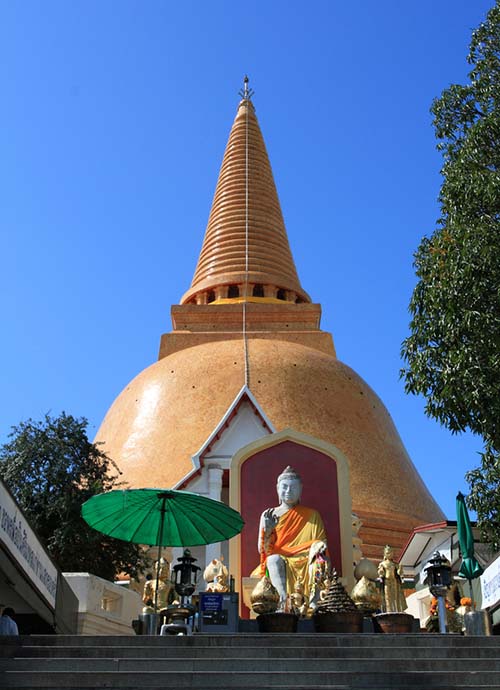
Phra Pathom Chedi
Oldest Buddhist structure in Thailand
One of the most important places for Buddhists in Thailand can be found in Nakhon Pathom, one of the oldest cities in Thailand.
Largest chedi in the world
The Phra Pathom chedi, which means “Holy chedi of the beginning” is regarded the oldest Buddhist structure in Thailand. The very impressive chedi (stupa) with its orange roof visible from far away is with its 120 meters height the largest Buddhist chedi in the world.
Third century BC
The history of the chedi goes back all the way to around the 3rd century BC, when Buddhism was introduced to Thailand. The Indian emperor Ashoka decided then to send out monks over many parts of Asia, including Thailand, to spread Buddhism.
The Great Stupa of Sanchi
The chedi was modeled after the Great Stupa of Sanchi in Central India, which is now a UNESCO World Heritage Site, and that was built in the 3rd century BC by order of emperor Ashoka. Monks from India brought over relics from the Buddha, that were enshrined in the Phra Pathom chedi.
In those days Nakhon Pathom was located on the Gulf of Thailand. Since then because of sedimentation from the Chao Phraya river the land progressed more towards the South and Nakhon Pathom was no longer a coastal city.
When the local river also dried up, the city was abandoned and eventually overgrown by jungle, with its inhabitants moving to the nearby town Nakhon Chai Si. Only during the first half of the 19th century the city became inhabited again.
Restoration of the chedi by King Mongkut
King Mongkut, who before he became King, spent many years as a monk travelling the country, visited the chedi a number of times. The chedi at that time was in a very bad state of repair and overgrown by jungle.
After Mongkut ascended the throne in 1851 he ordered the restoration of the Phra Pathom chedi. The original much smaller stupa was to be covered by a much larger chedi to be newly build. After 17 years of construction, during the reign of Mongkut’s successor King Chulalongkorn (Rama V) the chedi was completed. The original much smaller stupa still exists today, covered by the large 19th century structure.
When the chedi was finished, the population of nearby Nakhon Chai Si was ordered to return to the town of Nakhon Pathom. Surrounding the stupa that has a base of 233 meters is a courtyard with four viharns that each contain Buddha images in different postures.

Phra Ruang Rodjanarith standing Buddha
The viharn at the Northern end contains a large gilt standing Buddha image named Phra Ruang Rodjanarith. The image displays the Abhaya mudra, the fear dispelling gesture.
The Buddha image was restored by King Vajiravudh (Rama VI). In 1909, when he was Crown Prince, he discovered the statue badly damaged in the ground in Si Satchanalai. Only the head, hands and feet were in good condition. The statue was cast in Bangkok and installed in the viharn in 1915. The ashes of King Rama VI are installed in the base of the statue.
Another viharn contains a large Reclining Buddha image. Walking around the chedi through the courtyard you will find a number of bells that you can ring for good luck, as well as a large number of Buddha images in various postures.
The Wat Phra Pathom Chedi Museum and the National Museum of Phra Pathom Chedi have an interesting display of artifacts found during excavations in Nakhon Pathom, including stone carvings and Buddhist relics, some of which dating back as far as the Dvaravati era. Next to the chedi is a large market selling Buddhist amulets. Here you will also find many food stalls where you can try all kinds of original Thai food.
How to get to the Phra Pathom chedi
The chedi is located in the center of Nakhon Pathom, a little over one kilometer South East of the train station. Multiple daily train services from Bangkok’s Hua Lamphong station will get you there in around 1½ hours.
A bus from Bangkok’s Southern bus terminal in Bangkok Noi will take around one hour. A van from Victory Monument in downtown Bangkok can drop you off directly at the chedi.
The quickest way to get to the chedi from Bangkok is by private taxi. Most hotels can book one for you. If you book the taxi for the day, you can also visit nearby Sanam Chandra Palace or see the Damnoen Saduak floating market. Agree with the driver on the price and places to stop before setting off.
Opening hours
The temple complex is open daily from 7 am until 8 pm.
The Wat Phra Pathom Chedi Museum opens daily from 9 am until 4:30 pm except Mondays and Tuesdays.
Entrance fees
Admission charged at the ticket booth is (Thai Baht):